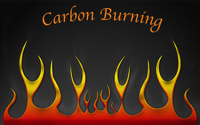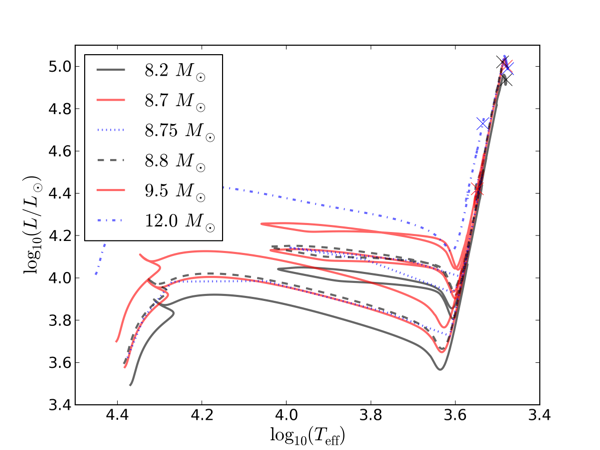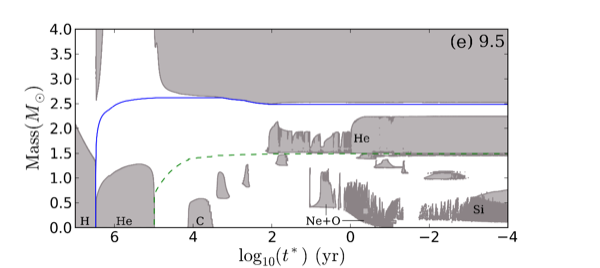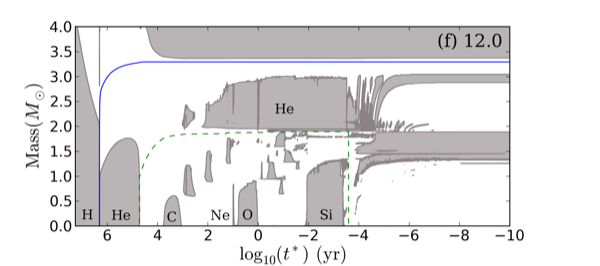
|
Cococubed.com
|
| Super-AGB Stars |
Home
Astronomy research
Software Infrastructure:
MESA
FLASH-X
STARLIB
MESA-Web
starkiller-astro
My instruments
Neutrino Emission:
Neutrinos from de-excitation
Neutrino emission from stars
Identifying the Pre-SN
Neutrino HR diagram
Pre-SN Beta Processes
Pre-SN neutrinos
White dwarf pulsations:
12C(α,γ) & overshooting
Probe of 12C(α,γ)16O
Impact of 22Ne
Impact of ν cooling
Variable white dwarfs
MC reaction rates
Micronovae
Novae
White dwarf supernova:
Stable nickel production
Remnant metallicities
Colliding white dwarfs
Merging white dwarfs
Ignition conditions
Metallicity effects
Central density effects
Detonation density
Tracer particle burning
Subsonic burning fronts
Supersonic fronts
W7 profiles
Massive stars:
Pop III with HST/JWST
Rotating progenitors
3D evolution to collapse
MC reaction rates
Pre-SN variations
Massive star supernova:
Yields of radionuclides
26Al & 60Fe
44Ti, 60Co & 56Ni
SN 1987A light curve
Constraints on Ni/Fe
An r-process
Effects of 12C +12C
Neutron Stars and Black Holes:
Black Hole spectrum
Mass Gap with LVK
Compact object IMF
He burn neutron stars
Stars:
Hypatia catalog
SAGB stars
Nugrid Yields I
He shell convection
BBFH at 40 years
γ-rays within 100 Mpc
Iron Pseudocarbynes
Pre-Solar Grains:
C-rich presolar grains
SiC Type U/C grains
Grains from massive stars
Placing the Sun
SiC Presolar grains
Chemical Evolution:
Radionuclides in 2020s
Zone models H to Zn
Mixing ejecta
Thermodynamics, Opacities & Networks
Radiative Opacity
Skye EOS
Helm EOS
Five EOSs
Equations of State
12C(α,γ)16O Rate
Proton-rich NSE
Reaction networks
Bayesian reaction rates
Verification Problems:
Validating an astro code
Su-Olson
Cog8
Mader
RMTV
Sedov
Noh
Software Instruments
2026 AAS Journals
AAS YouTube
Listing of 500+ Author Videos
AAS Peer Review Workshops
Outreach Material
Education Material
Other Stuff:
Bicycle Adventures
Illustrations
Presentations
Contact: F.X.Timmes
my one page vitae,
full vitae,
research statement, and
teaching statement.
Here we describe an idealized model of convectively bounded carbon flames with 3D hydrodynamic simulations of the Boussinesq equations using the pseudospectral software instrument Dedalus.
On Carbon Burning in Super Asymptotic Giant Branch Stars (2015)
In this article we explore the detailed and broad properties of carbon burning in SAGB stars with 2755 MESA stellar evolution models. The location of first carbon ignition, quenching location of the carbon burning flames and flashes, angular frequency of the carbon core, and carbon core mass are studied as a function of the ZAMS mass, initial rotation rate, and mixing parameters such as convective overshoot, semiconvection, thermohaline and angular momentum transport.
In general terms, we find these properties of carbon burning in SAGB models are not a strong function of the initial rotation profile, but are a sensitive function of the overshoot parameter. We quasi-analytically derive an approximate ignition density, ρign ≈ 1.3 × 106 g cm-3, to predict the location of first carbon ignition in models that ignite carbon off-center. We also find that overshoot moves the ZAMS mass boundaries where off-center carbon ignition occurs at a nearly uniform rate of Δ MZAMS/Δfov ≈ 1.6 M☉. For zero overshoot, fov=0.0, our models in the ZAMS mass range ≈ 8.9 to 11 M☉ show off-center carbon ignition. For canonical amounts of overshooting, fov=0.016, the off-center carbon ignition range shifts to ≈7.2 to 8.8 M☉. Only systems with fov ≥ 0.01 and ZAMS mass ≈7.2 - 8.0 M☉ show carbon burning is quenched a significant distance from the center. These results suggest a careful assessment of overshoot modeling approximations on claims that carbon burning quenches at an appreciable distance from the center of the carbon core.
 SAGB illustration |

3 slices, 2418 MESA models |

kippenhahn 7.5 M☉ |

ignition point moves inwards |

angular momentum evolution |

ignition location in mass-over plane |
Advanced burning stages and fate 8-10 M☉ stars
The stellar mass range 8 ≲ M/M☉ ≲ 12 corresponds to the most massive AGB stars and the most numerous massive stars. It is host to a variety of supernova progenitors and is therefore very important for galactic chemical evolution and stellar population studies. In this article, we study the transition from super-AGB star to massive star and find that a propagating neon-oxygen burning shell is common to both the most massive electron capture supernova (EC-SN) progenitors and the lowest mass iron-core collapse supernova (FeCCSN) progenitors.
Of the models that ignite neon burning off-center, the 9.5 M☉ would evolve to an FeCCSN after the neon-burning shell propagates to the center, as in previous studies. The neon-burning shell in the 8.8 M☉, however, fails to reach the center as the URCA process and an extended (0.6 M☉) region of low Ye (0.48) in the outer part of the core begin to dominate the late evolution; the model evolves to an EC-SN. This is the first study to follow the most massive EC-SN progenitors to collapse, representing an evolutionary path to EC-SN in addition to that from SAGB stars undergoing thermal flashes. We also present models of an 8.75 M☉ super-AGB star through its entire thermal pulse phase until electron captures on 20Ne begin at its center and of a 12 M☉ star up to the iron core collapse. We discuss key uncertainties and how the different pathways to collapse affect the pre-supernova structure. Finally, we compare our results to the observed neutron star mass distribution.

HR diagram |

Divergence after C burn |

kippenhahn 8.8 M☉ |

kippenhahn 9.5 M☉ |

kippenhahn 12 M☉ |

flame temperature profiles 8.8 M☉ |